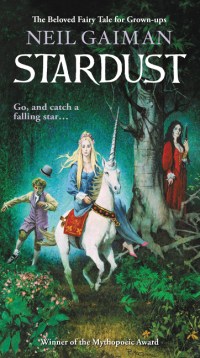Stardust
by Neil Gaiman
HarperCollins; Reprint edition
[Challenge # 1: Coming to theater near you]
I had never read Neil Gaiman before, so I was pleasantly surprised by his “Fairy tale for Grown-ups” Stardust. (A movie was made of it in 2007 starring Clare Danes and Charlie Cox, but I haven’t seen it, so can’t compare.) It was not a long book, nor a quest one in the Tolkien mode, or an urban fantasy. The closest analog I can find to describe it would be Lord Dunsany crossed with hedge fantasy, that typically English genre where fairies and hobgoblins lurk yet in country villages or secret worlds in wardrobes. The basic plot did remind me, in fact, of Clive Barker’s Imagica — a sensual (read: there’s sex) parallel world with its own fantastic characters based on English tropes, and the hero who enters it — but without being detailed to death, or having Barker’s sense of claustrophobia.
Tristran — I kept reading it as Tristan — Thorn, the young hero, lives in one of those quaint villages that just happens to have a gate connecting it to the realms of Faerie. This isn’t made a big deal of in the story, just accepted by the inhabitants in a low-key, matter-of-fact way. Guards are posted at the gate to ensure no one enters, for their own safety. But once a year, Faerie denizens come to the meadow that is just beyond the gate, and a big fair takes place for them and the Victorian-era villagers alike. During one of these Tristan is conceived on a Faerie mother and left on his father’s doorstep after he is born. Again, not a lot of fuss is made about this. When he becomes a young man, he sees a shooting star fall beyond the Faerie gate and promises to retrieve it for the young woman he has a crush on, and thus starts the story. The star turns out to be a girl who was knocked out of the sky by a talisman thrown by a dying lord whose dastardly sons are out to retrieve it. At the same time, a witch is out to also capture the star for her youth-giving blood. Complications ensue between these four parties, their friends, and their enemies.
All this sounds chaotic, but it really wasn’t, again presented in a low-key, turn of the century way by an omniscient narrator who is calm and in control. The book read more epic and longer than it actually was, in a good way, which was refreshing to me. It kept my attention and I looked forward to the time I could read it, something that does not always happen with my recreational reading. The story did not have the rising-action-big climax-tiny denouement structure of a typical fantasy novel, which again was refreshing, and different. There were, in fact, several endings: the escape of the couple from Faerie, the revelation of the Tristran’s true heritage, his discovery that his crush was not who he thought she was and had a life of her own; and at least three more. These soft endings were refreshing after the big Hollywood climaxes of modern SF/fantasy, where it’s often heroes vs. bad guys in a titanic battle that goes on freaking forever, at the end of which the good guys escape by the slimmest of margins. Think of the climactic escape from the movie Chicken Run and you will understand what I mean, where the freedom of the heroes hinges on a string of Christmas tree lights and a blunt-nosed child’s pair of scissors. (This is amusingly spoofed in the slow-mo escape sequence at the end of the animated French movie The Triplets of Belleville, where it’s apparent the old ladies have the upper hand.)
I don’t think Gaiman is the quite the master of prose a lot of readers think he is, but his language fits the story, it’s succinct yet robust, and though he often approaches twee territory, he never really goes there. On the whole, an enjoyable read, and I would recommend it.


1 pings